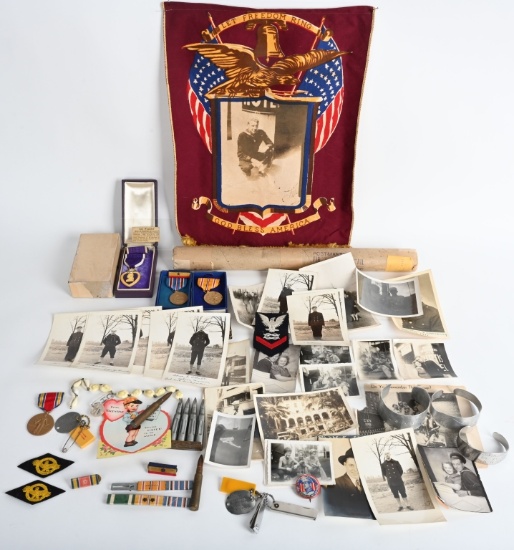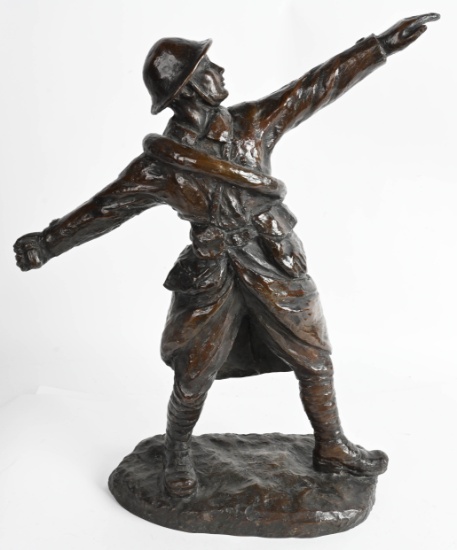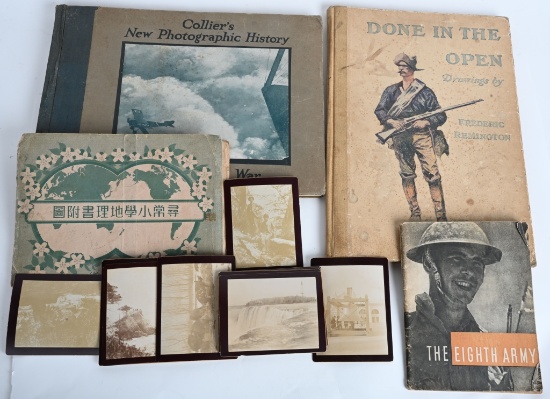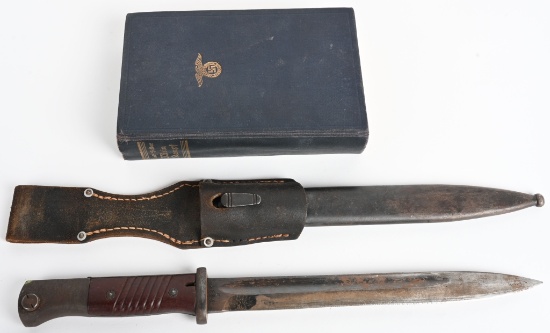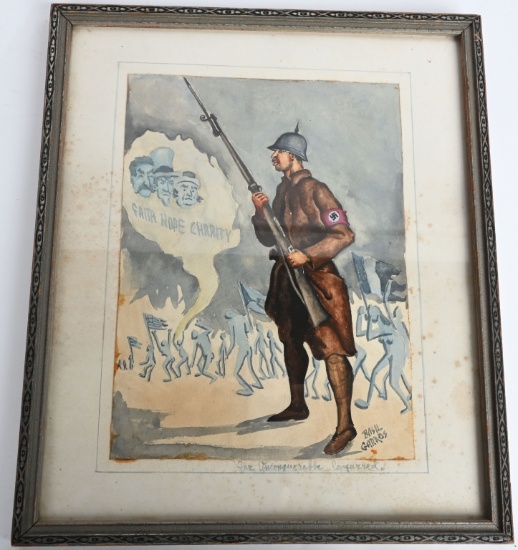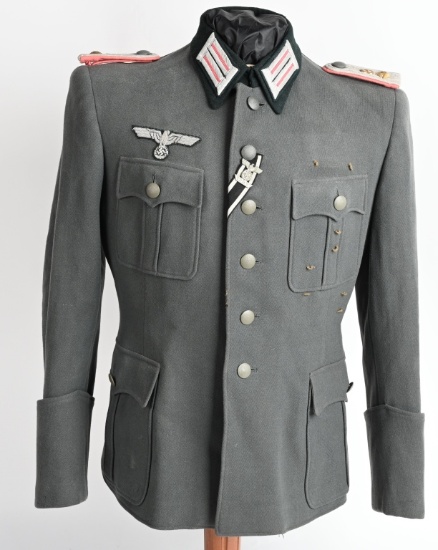
PREMIER MILITARIA & EDGED WEAPONS AUCTION

PREMIER MILITARIA & EDGED WEAPONS AUCTION
See Special Terms for additional fees
Cash Payment Discount: 3%
Description
PROUDLY PRESENTS
PREMIER MILITARIA & EDGED WEAPON AUCTION
OVER 700 LOTS OF MILITARIA FROM THE 18TH TO THE 20TH CENTURY. MORE THAN 25 LOTS of CIVIL WAR INCLUDING SWORDS, ACCOUNTREMENTS, IMAGES and MORE, INCLUDING AN IDENTIFIED CONFEDERATE POW'S SHELL JACKET;
WW1 and WW2 US GROUPINGS, EDGED WEAPONS, HELMETS, MEDALS, FLAGS, UNIFORMS, INSIGNIA, PATRIOTIC POSTERS and MORE INCLUDING MERRILL'S MARAUDERS GROUPING, NAMED MEDAL GROUPINGS, PAINTED COMBAT HELMETS, AND MORE. 30 PLUS LOTS of IMPERIAL GERMAN SWORDS, HEAD GEAR, MEDALS and MORE. 400 PLUS LOTS of WW2 NAZI GERMAN ITEMS INCLUDING a TRANSITIONAL WAFFEN SS HELMET, NAZI GERMAN ORG. TODT UNIFORM, NAZI GERMAN DIPLOMAT DAGGER, BADGES, MEDALS, INSIGNIA, HELMETS, UNIFORMS, SWORDS, BAYONETS, ACCOUTREMENTS, NSDAP PARTY UNIFORMS and MUCH MUCH MORE! JAPANESE ITEMS INCLUDING A PARATROOPER PARACHUTE, JAPANESE KATANA SWORDS, TANTOS, FLAGS, MEDALS, BADGES and MORE. KOREAN AND VIETNAM WAR LOTS, INERT ORDNANCE COLLECTION INCLUDING AN E1R1 FLAMETHROWER, INERT RPG, INERT MORTARS, INERT... Show more Show Less
Cash Payment Discount: 3%
Participation Requirements: Valid Credit Card required for bidding approval
Payment Options: Visa, MasterCard, Discover, American Express, Check, Money Order, and Wire Transfer
Visa MasterCard Discover American Express
Payment Instructions: SALES TAX All buyers will pay applicable state sales tax. Sales tax is require if mandated by the state you reside in for all internet sales and will be added to your invoice. If buyer provides a current state exemption form there will be no sales tax added. PAYMENT All merchandise must be paid in full within ten (10) days of the date of the sale. Purchases totaling $20,000 or more must be paid within three (3) days of the date of the sale. Call 440-527-8060 to pay your invoice by phone or mail payment to: 38198 Willoughby Parkway, Willoughby Ohio, 44094. Absentee bids placed through www.milestoneauctions.com and Proxibid.com will be auto charged to the credit card entered 48 hours after the end of the sale. If you wish to pay by another method please contact us within 48 hours after the sale. We accept Visa, MasterCard, Discover, personal checks/ certified checks, wire transfer, money orders, and cash. CREDIT CARD - For first time buyers and credit card charges greater than $2,500.00 buyers must complete the bottom portion of the invoice and must specifically sign the acknowledgement of our terms of sale before we will accept payment via credit card. We do offer the convenience of paying automatically by credit card. If you wish have your card automatically charged for all purchases please complete our Authorization for Automatic Credit Card Use. We have this form available upon request. Split payments are subject to a 23% buyer premium if a credit card is used as any form of total payment. CHECK - There will be a $30.00 service charge for returned checks. Make checks payable to: Milestone Auctions LLC. Milestone Auctions reserves the right to hold items paid for by personal or company check until said check clears (14 days). Milestone Auctions has the right to hold all checks over $2,000.00. Customers who have an established successful buying In the few situations where a successful bidder does not remit payment when due, Milestone Auctions will proceed with the legal steps necessary to protect its interests and will block the bidder from future auction participation.
Currency Type: USD
Shipping Instructions: Please see our terms and conditions.
Preview Date & Times: Items are available for preview 7 days prior to the sale by appointment. Auction day preview is February 13th at 8AM.
Checkout Date & Times: Please contact the auction company for checkout dates & times.
Location: 38198 Willoughby Parkway, Willoughby, OH 44094
Driving Directions:

By clicking "Confirm Buy" you are agreeing to the terms of the sale. Instant Purchase items may have additional fees such as an Internet Premium, Sales Tax, Shipping or other fees not included in the Instant Purchase price. Please see Auction Information for full details.
Payment Type:
WWI + WWII US 1911 + M1911A1 PISTOL HOLSTERS
Lot # 512 (Sale Order: 576 of 784)
WWII US NAMED SILVER STAR MEDAL GROUPING
Lot # 513 (Sale Order: 577 of 784)
WWII US NAVY PURPLE HEART GROUPING IWO JIMA
Lot # 514 (Sale Order: 578 of 784)
WWII MARINE CORPS GROUPING + AAF ITEMS
Lot # 515 (Sale Order: 579 of 784)
WWII NAZI GERMAN WAFFEN SS M43 VISOR CAP SIZE 56
Lot # 516 (Sale Order: 580 of 784)
WWII US CBI INSIGNIA GROUPING BLOOD CHIT LEATHER
Lot # 517 (Sale Order: 581 of 784)
WWII US MILITARY POSTER DISSOLUTION OF NAZI PARTY
Lot # 518 (Sale Order: 582 of 784)
LARGE WW1 US DOUGHBOY BRONZE THROWING GRENADE WWI
Lot # 519 (Sale Order: 583 of 784)
WWII NAZI GERMAN ORIGINAL BOOK LOT OF 8 NSKOV WW2
Lot # 520 (Sale Order: 584 of 784)
WWII NAZI GERMAN BOOK LOT OF 8 MOUNTAIN TROOPS WW2
Lot # 521 (Sale Order: 585 of 784)
WWII NAZI GERMAN CIGARETTE CARD ALBUM LOT OF 3 WW2
Lot # 522 (Sale Order: 586 of 784)
WWII NAZI GERMAN BOOK LOT OF 11 ADOLF HITLER HEER
Lot # 523 (Sale Order: 587 of 784)
EARLY MILITARY BOOKS PHOTOS LOT REMINGTON PRINTS
Lot # 524 (Sale Order: 588 of 784)
WWII NAZI GERMAN LKPN101 SUMMER FLIGHT HELMET WW2
Lot # 525 (Sale Order: 589 of 784)
WWII NAZI GERMAN K98 BAYONET MEIN KAMPF 1939 WW2
Lot # 526 (Sale Order: 590 of 784)
WWII NAZI GERMAN HITLER YOUTH SLEEVE TRIANGLE LOT
Lot # 527 (Sale Order: 591 of 784)
WWII ULTRA RARE E1R1 FLAMETHROWER WAND COMPLETE
Lot # 528 (Sale Order: 592 of 784)
WWII ULTRA RARE E1R1 FLAMETHROWER TANKS #18 WW2
Lot # 529 (Sale Order: 593 of 784)
WWII BRITISH MADE 101ST AIRBORNE PATCH ROCKER WW2
Lot # 530 (Sale Order: 594 of 784)
WWII US FIRST SPECIAL SERVICE FORCES PATCH LOT WW2
Lot # 531 (Sale Order: 595 of 784)
WWII US PARATROOPER WINGS LOT A&E & BELL MARKED
Lot # 532 (Sale Order: 596 of 784)
WWII FLYING TIGERS CHINESE AIR FORCE WINGS WW2 #ed
Lot # 533 (Sale Order: 597 of 784)
WWII NAZI GERMAN REICH & GAU FRAUNENSCHAFT BADGE
Lot # 534 (Sale Order: 598 of 784)
WWII ANTI NAZI GERMAN PATRIOTIC PAINTING WW2 KIA
Lot # 535 (Sale Order: 599 of 784)
WWII US ARMY WAC WOMEN'S ARMY CORPS WHITE TUNIC
Lot # 536 (Sale Order: 600 of 784)
| Bid Range | Increment |
| $0.00 - $299.99 | $10.00 |
| $300.00 - $999.99 | $25.00 |
| $1,000.00 - $1,999.99 | $50.00 |
| $2,000.00 - $4,999.99 | $100.00 |
| $5,000.00 - $9,999.99 | $250.00 |
| $10,000.00 - $24,999.99 | $500.00 |
| $25,000.00 - $49,999.99 | $1,000.00 |
| $50,000.00 - $99,999.99 | $2,500.00 |
| $100,000.00+ | $5,000.00 |

 x Cancel
x Cancel

